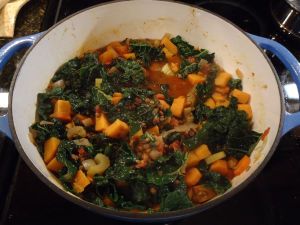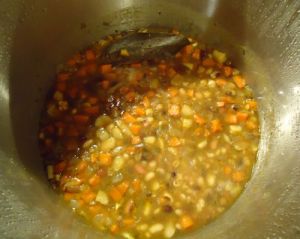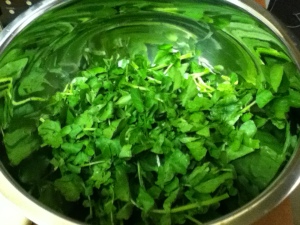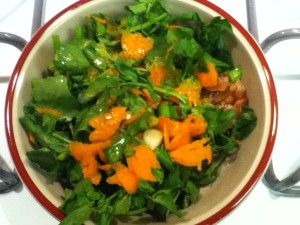A new soup recipe to start your February off right! It’s a good day for soup today–as I write this it is a whopping -5 degrees outside with a windchill of -24 F. Yeah, that’s right: -24. But this hearty and spicy soup will warm you right up, and as an added bonus, it’s healthy too!
I actually didn’t originally intend for this soup to be a blog recipe–I came across Smitten Kitchen’s soup with lentils, sausage, chard and garlic while making my grocery list for the week, and had every intention of making it exactly according to the recipe. Since our household’s resident vegetarian was going to be out for the night, I was excited at the prospect of trying my hand at a recipe using meat. I figured I’d just make two pots, one with Italian sausage and one without so that my husband could share in the leftovers.
When I got to the grocery store, I discovered that sweet potatoes were on sale. I like sweet potatoes, and I figured they’d go well with the Italian sausage, so I picked some up. Then I went looking for the sausage itself. The recipe called for sweet Italian sausage, which I found, but in my opinion Italian sausage should always be spicy. Alas, spicy Italian sausage was nowhere to be seen. Of course, I could just add my own spices after the fact, but I decided that if I was going to spice it myself anyways, I should buy something healthier. That was when I saw the package of ground chuck. It was three quarters of a pound–just the right amount given that I’d be the only one eating it. Perfect.
At this point I was still intending to follow the recipe (just with the meat substitution and the addition of sweet potatoes), but I kept thinking about how big of a nuisance it would be to make two separate pots of soup (and how I didn’t really have two appropriately sized/shaped pots to do this), when finally the idea of doing meatballs popped into my brain. I could make spicy meatballs to put in the bottom of my bowl with the soup, leaving the leftover soup untainted by meat so that my husband could share in it later!
So then I had to figure out how to make meatballs. Because I’d never done it before. (Yeah, yeah, I know–I write a cooking blog and I’ve never even made meatballs. I’ve never made a steak either.) But how hard could it be? I figured I needed meat, breadcrumbs, and egg plus some spices, but I decided to consult Google just to be sure I wasn’t missing anything.
As it turns out, most meatball recipes call for fresh breadcrumbs. From white bread. With the crusts cut off. Well, I didn’t actually have any white bread, crusts or no. I had a jar of panko breadcrumbs. And since it was freezing cold out, my car was covered in snow, and its door likely frozen shut, I decided to just go with it.
In the end, panko worked just fine and the meatballs turned out to be juicy and flavorful.
Since I decided to make meatballs, the soup was no longer going to have any contact with the meat, and thus was not going to get any of the flavors of it. So I needed to up the spice content. I decided to use the same spices I used in the meatballs (fennel seeds, smoked paprika, red pepper flakes, garlic powder, salt, and pepper) along with a star anise. I also put this same combination of spices into the sauce for the meatballs.
In the end, this turned out to be a ridiculous amount of soup. Unless I freeze some, I’m not going to have to grocery shop or cook for a week. Which may be a good thing as I look at the weather forecast…
Sweet Potato Lentil Soup (with meatballs)
(serves 6)
Soup:
- 3 tbsp grapeseed oil
- 1/2 tbsp fennel seed
- 1 whole star anise
- 2 ribs of celery, sliced or diced
- 2 large carrots, sliced or diced
- 1 medium onion, diced
- 2 medium or 3 small sweet potatoes, chopped into 3/4″ cubes
- 1 tsp garlic powder
- 1/2 tsp smoked paprika
- scant 1/2 tbsp red pepper flakes
- 1/4 tsp salt
- a few grinds of pepper
- 1 large bay leaf
- 1 cup dry black lentils, picked over and rinsed
- 1 can (14oz) crushed tomatoes (fire roasted if you can find them)
- 3.5 cups water
- 1 large bunch of kale, roughly chopped
Meatballs:
- 1lb ground chuck (I used a bit less, but I thought the meatballs could have been a bit meatier)
- 1 cup panko breadcrumbs
- 1 large egg, lightly beaten
- 1/3 cup freshly grated Parmesan cheese
- 1/2 tsp garlic powder
- 1/4 tsp black pepper
- 1/4 tsp smoked paprika
- 1 tsp fennel seeds
- 1/4 tsp red pepper flakes
- a small pinch of salt
- grapeseed oil for frying
Sauce:
- 1 can (14oz) crushed tomatoes (again, fire roasted if possible)
- a small pinch of salt
- a small pinch of smoked paprika
- a few grinds of black pepper
- a small pinch of red pepper flakes
- a small pinch of garlic powder
- 1 bay leaf
- 1 whole star anise
- a splash of water–just enough to thin it out
Heat the 3 tbsp of grapeseed oil in a large pot or dutch oven over medium heat. Add the fennel seeds and star anise for the soup, and stir them around for a minute or two until they start to get fragrant. Add the celery, onion, carrots, sweet potato, and all of the spices except for the bay leaf. Cook the vegetables for a few minutes until the onions start to get translucent. Then add the water, tomatoes, lentils, and bay leaf. Stir, and then cover and simmer for 20 minutes.
After 20 minutes have passed, check on your soup, give it a stir, and then cover it and set a timer for another 20 minutes. Combine the sauce ingredients in a pyrex measuring cup or other dish that pours easily. Set aside. Meanwhile in a large metal bowl, mix together your breadcrumbs, spices, and the Parmesan cheese for the meatballs. Then add the ground chuck and beaten egg, and mix it with your hands until it’s just uniformly combined. Yes, you should really use your hands, and be careful not to overmix (you don’t want the meatballs to be tough!) Form the mixture into balls, about an inch and a quarter in diameter. I ended up with 18 of them.
Add just enough grapeseed oil to just coat the bottom of a saute pan over medium high heat. When the pan is hot (you can test this by gently setting one of your meatballs in it–if it sizzles, it’s hot enough), add all of your meatballs in a single layer, and use a pair of tongs to turn them occasionally until they’re browned on all sides. How do you know when it’s time to turn them? When they stop sticking to the bottom of the pan. Seriously, don’t worry if they stick at first–they’ll come unstuck. Once they’re browned on all sides, you can take the pan off the heat and skim out a bit of the excess oil if it seems like there’s a lot (do this quickly–you don’t want the pan to cool!), and then deglaze the pan with your tomato sauce mixture. Be careful–it splashes. Reduce the heat to low, and cover the pan. Simmer for 10 minutes to cook the meatballs through.
Meanwhile, your soup timer has probably gone off. Give the soup a taste, and check if the lentils are done. If they’re not, keep the soup simmering. Adjust seasonings as necessary, and then when the lentils are done, turn the soup down to low to keep it warm until the meatballs are ready.
Check the internal temperature of the meatballs–you want to see at least 165 degrees. Make sure you check meatballs both in the middle of the pan and on the edges–mine cooked much faster on the edges of the pan than in the middle, so I ended up moving them around partway through.
Once the meatballs are done, put three of them in the bottom of a bowl, cover it with soup, and enjoy!



















